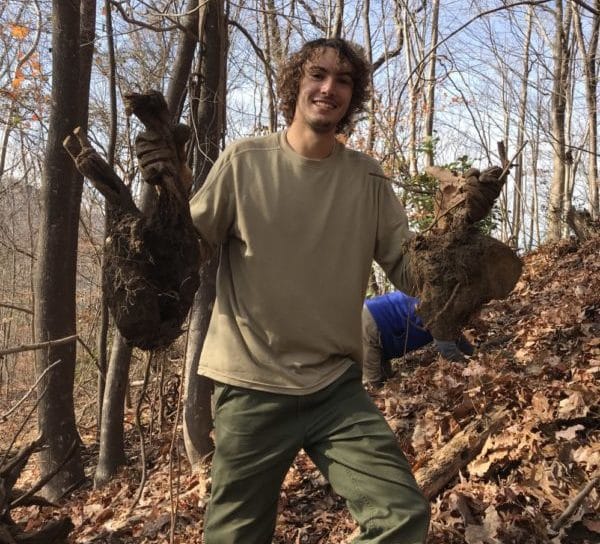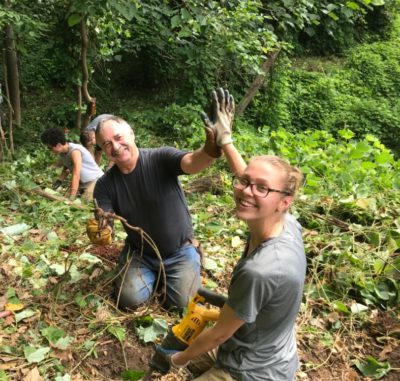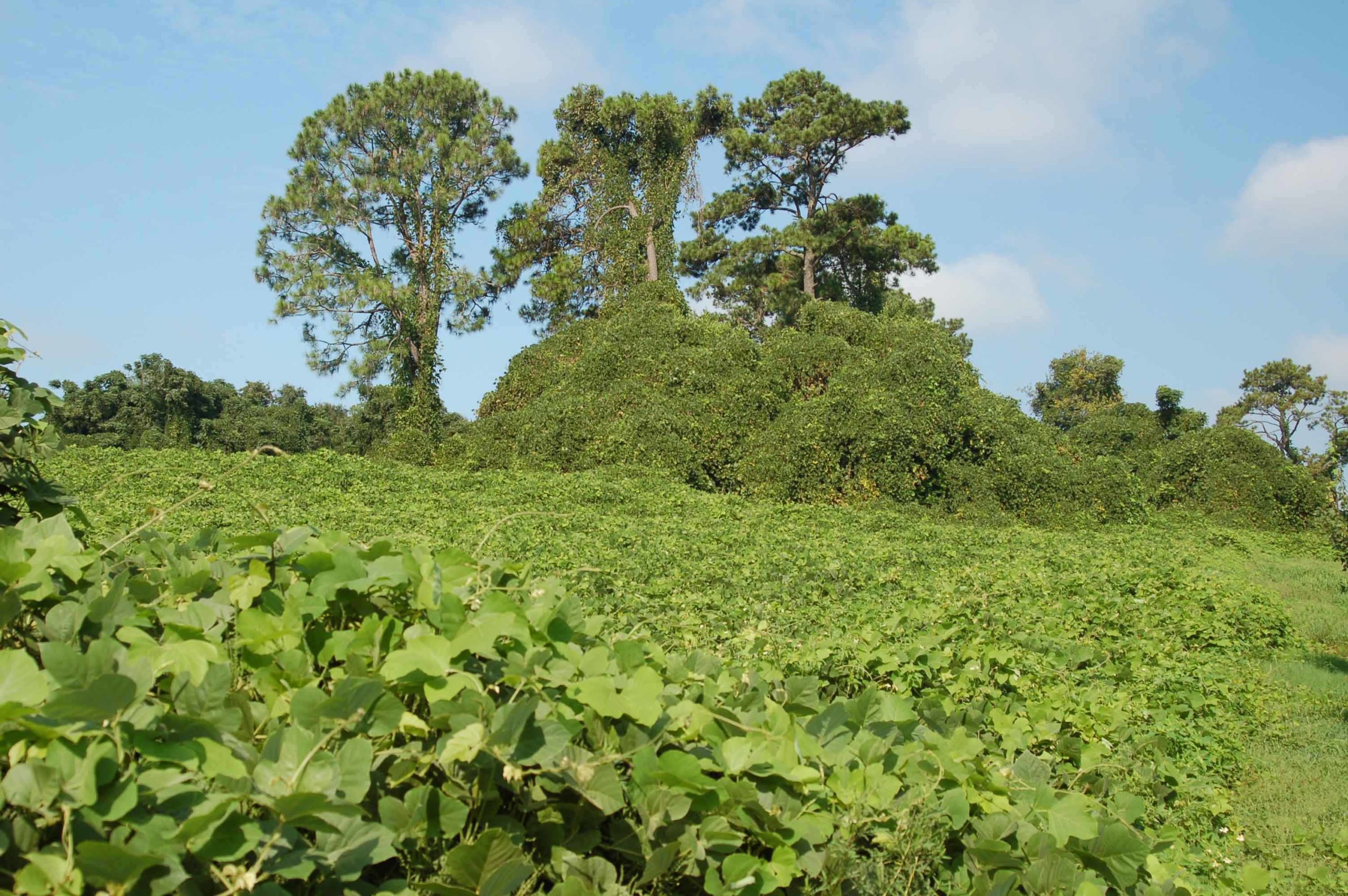What to Do About Kudzu
Learn what you can do to remove this invasive plant and make your land a thriving habitat for native plants, animals, and insects.
It’s no secret that there is a kudzu problem in the South. It covers the ground, buildings, trees, you name it! Kudzu crowds out native plants, greatly reducing your habitat potential. In this Habitat at Home feature, we talk to two of Conserving Carolina’s kudzu experts—David Lee and Max Howes—to find out what you can do if you have a kudzu problem on your land.
Identifying Kudzu
 Kudzu is a perennial vine generally identified by the three broad leaves at the end of each protruding stem. Kudzu leaves are huge, sometimes growing to be seven or eight inches long! It can grow up to 1 foot per day – easily out competing other plants in its path. While kudzu was originally brought over from Japan to be used in erosion control, it has a fairly poor root system when it comes to holding land in place.
Kudzu is a perennial vine generally identified by the three broad leaves at the end of each protruding stem. Kudzu leaves are huge, sometimes growing to be seven or eight inches long! It can grow up to 1 foot per day – easily out competing other plants in its path. While kudzu was originally brought over from Japan to be used in erosion control, it has a fairly poor root system when it comes to holding land in place.
Catch It Early!
Our Trails and Land Management Coordinator, Max Howes, who leads our volunteer group the Kudzu Warriors, says that the best way to remove kudzu is to prevent its growth in the first place. “Try to eradicate kudzu before it becomes a bigger problem—look for small infestations and treat immediately before it has the chance to spread. Even just removing it off the trees is better than letting it go untouched.”
How to Dig Up the Kudzu Crown—and Kill the Plant
Mechanical control just means using your body or tools to remove the plant! While this method may be the most time consuming, it can be the easiest on the environment. Make sure you do it right – or you will be pulling kudzu in the same spot next year! Here is what Max recommends:
“The key is to remove the crown, not the entire root! Follow the vine to the ground and dig there. The crown is a bulb-like feature at the top of the root system which holds the energy of the vine. If you remove the crown, the vine will die and there is no need to dig up the remaining taproots which can be quite long. Cut the vine above and dig around the crown to remove it from the taproots. When kudzu is growing along the ground, it can develop multiple spots where it may send down taproots (and eventually form a second crown if it’s old enough) so be sure to follow the vine to where it no longer runs on the ground. This method is effective though it is labor intensive and can be slow.”

Mowing—or Goats
Max notes, “Repeated mowing can also kill kudzu eventually, though one needs to be persistent with this or it is just a short term solution.” Goats essentially act as mowers with hooves—so the same goes for goats.
Should You Use Chemicals?
The most effective methods of removing kudzu typically involve both chemical control and mechanical control. However, chemicals can potentially be harmful to the surrounding environment.
There are various schools of thought about best practices for the use of herbicide in controlling kudzu. We try to err on the side of caution. When we treat kudzu with herbicides, we always factor in the following:
- The plant itself: Kudzu is a legume, so we use an herbicide that is targeted to kill legumes. This greatly reduces the impact on other plants.
- The surrounding environment: Conserving Carolina strives to use herbicides that are least harmful to people and the environment, which generally means aquatic herbicides—that is, herbicides that are approved for use in bodies of water.
- The method of application: Due to the steep terrain and large size of most kudzu infestations, the most effective method is often through spraying the foliage (leaves) of the plant. Generally this is done multiple times throughout the growing period, usually summer and fall. Alternatively, if you are digging out kudzu crowns, you can spot-spray any portion of the crown that may have broken off underground.
There are a lot of considerations, so consult a professional to help you choose an herbicide for your specific situation. Always follow the directions and safety precautions on the label! Or, hire a qualified landscaping professional.
How Much Kudzu Are We Talking About?
- For small patches and newly infested areas, start with mechanical control such as hand pulling and digging out and removing the root crowns. If the kudzu is growing in an area that can be mowed, persistent mowing from May to October each year will eventually kill the kudzu. Follow up mechanical treatment with herbicide by spraying the foliage of re-sprouts, or cutting the tops of the root crown and painting herbicide directly on to the cut surface.
- For larger areas overtaken by kudzu, goats are a great option. Persistent grazing of the area during the growing season will control kudzu. If goats are not an option for you, start by controlling the perimeter of the area—hold the line! Mowing, hand-pulling, or herbicide can be used to prevent the kudzu from spreading. Work your way closer and closer to the center each year. If you have the ability, controlling the entire area each year with herbicide may be your most effective approach.
An Integrated Approach
While any attempt to remove kudzu can be helpful for the overall health of your land, the most effective way to successfully eradicate kudzu is through integrated pest management (IPM). IPM is a combination of removal methods—mechanical, chemical, and biological (through the use of goats or beneficial insects) and should be implemented for several years. While not an easy task by any means, this combination of methods should eventually reduce or eradicate the kudzu on your land.
Tips and Demonstration by the Kudzu Warriors
In this video by AmeriCorps member Pat Barcas, members of Conserving Carolina’s Kudzu Warriors volunteer crew demonstrate how to successfully manage a kudzu infestation.
Volunteering is Free Training

Our volunteers prove that controlling kudzu is tough but not impossible. In fact, one of our volunteer groups, the Kudzu Warriors, has restored large sections of Norman Wilder Forest that used to be solid kudzu! Other volunteer groups take on invasive plants throughout our region. Our volunteers say there are many benefits, including the knowledge that you’re contributing to something greater than yourself and the camaraderie of working together. They also point out that it’s free training so you know how to manage invasive plants on your own land.
check out VOLUNTEER opportunities
Professional Services
For advice on managing kudzu on your land, you can call your local Cooperative Extension office. The Extension is a public agency that provides personalized land management support.
In addition, here are some professional services that offer environmentally sensitive kudzu management. We are not endorsing these services; please do your own research before deciding to hire anyone. This list is not intended to be exhaustive. If you know of other businesses that specialize in environmentally sensitive invasive plant management, feel free to let us know.
Interested in improving habitat where you live? We offer seasonal tips on how to make your yard and home a better habitat for native plants, animals, and insects. Explore more Habitat at Home topics here. You can also sign up for Conserving Carolina emails to get the latest Habitat at Home columns in your inbox.
Habitat at Home is a monthly segment dedicated to providing you with tips to make your yard and home a better habitat for native plants, animals, and insects. This month’s Habitat at Home is written by Kelly Holland.
